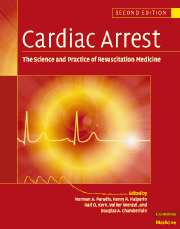Book contents
- Frontmatter
- Contents
- List of contributors
- Foreword
- Preface
- Part I Introduction
- Part II Basic science
- Part III The pathophysiology of global ischemia and reperfusion
- Part IV Therapy of sudden death
- Part V Postresuscitation disease and its care
- Part VI Special resuscitation circumstances
- 52 Prevention of sudden death in patients at risk: channelopathies and arrhythmic syndromes in the structurally normal heart
- 53 Pediatric cardiopulmonary resuscitation
- 54 Resuscitation in elder persons
- 55 Asphyxial cardiac arrest
- 56 Hemorrhagic shock and hypovolemic cardiac arrest
- 57 Cardiopulmonary resuscitation in hypothermic patients
- 58 Cardiac arrest due to poisoning
- 59 Cardiac arrest during anesthesia
- 60 Resuscitation of the pregnant patient suffering sudden cardiac death
- 61 Drowning
- 62 Anaphylactic shock
- 63 High altitude resuscitation
- 64 Electrical injuries
- 65 Rare syndromes, commotio cordis, sudden death in athletes
- Part VII Special issues in resuscitation
- Index
56 - Hemorrhagic shock and hypovolemic cardiac arrest
from Part VI - Special resuscitation circumstances
Published online by Cambridge University Press: 06 January 2010
- Frontmatter
- Contents
- List of contributors
- Foreword
- Preface
- Part I Introduction
- Part II Basic science
- Part III The pathophysiology of global ischemia and reperfusion
- Part IV Therapy of sudden death
- Part V Postresuscitation disease and its care
- Part VI Special resuscitation circumstances
- 52 Prevention of sudden death in patients at risk: channelopathies and arrhythmic syndromes in the structurally normal heart
- 53 Pediatric cardiopulmonary resuscitation
- 54 Resuscitation in elder persons
- 55 Asphyxial cardiac arrest
- 56 Hemorrhagic shock and hypovolemic cardiac arrest
- 57 Cardiopulmonary resuscitation in hypothermic patients
- 58 Cardiac arrest due to poisoning
- 59 Cardiac arrest during anesthesia
- 60 Resuscitation of the pregnant patient suffering sudden cardiac death
- 61 Drowning
- 62 Anaphylactic shock
- 63 High altitude resuscitation
- 64 Electrical injuries
- 65 Rare syndromes, commotio cordis, sudden death in athletes
- Part VII Special issues in resuscitation
- Index
Summary
Incidence and current outcomes of post-traumatic cardiopulmonary arrest
Traumatic injury is the leading cause of death among adults under 44 years of age, and it is a worldwide problem. In the year 2000, road traffic injuries were the ninth leading cause of death in the world and this toll is predicted to increase significantly in the next 15 years as road traffic injuries increase in underdeveloped countries. Because traumatic injury has a predilection for the young, it is a major cause of productive life-years lost and it is predicted that by the year 2020, traumatic injury will match or surpass infectious diseases as the leading cause of productive life-years lost world-wide. The greatest opportunity to save lives is to improve early care since the majority of traumatic deaths occur within the first few hours after injury.
In the United States as many as 34% of all trauma deaths occur pre-hospital and two major mechanisms predominate as the cause of early death: blood loss and injury to the central nervous system (CNS). In a study by Sauaia et al. in 1995, 43% of the overall deaths were due to injury to the central nervous system (CNS), 39% were relegated to exsanguination, and 7% died from multiorgan failure. More recent studies have indicated that the mortality of post-traumatic multi-organ failure is decreasing as a result of improvements in ICU care and now multi-organ failure may account for less than 4% of all traumatic deaths. Multiorgan failure occurs several days after injury while the majority of both CNS and hemorrhage deaths occur within the first 2 hours of injury.
- Type
- Chapter
- Information
- Cardiac ArrestThe Science and Practice of Resuscitation Medicine, pp. 994 - 1013Publisher: Cambridge University PressPrint publication year: 2007



